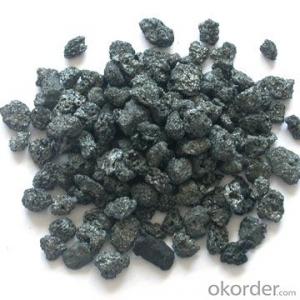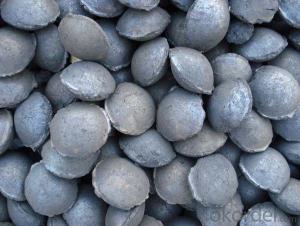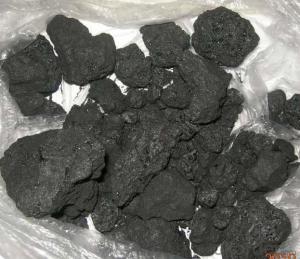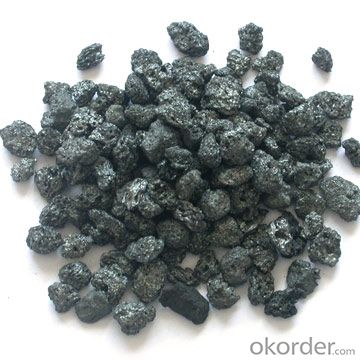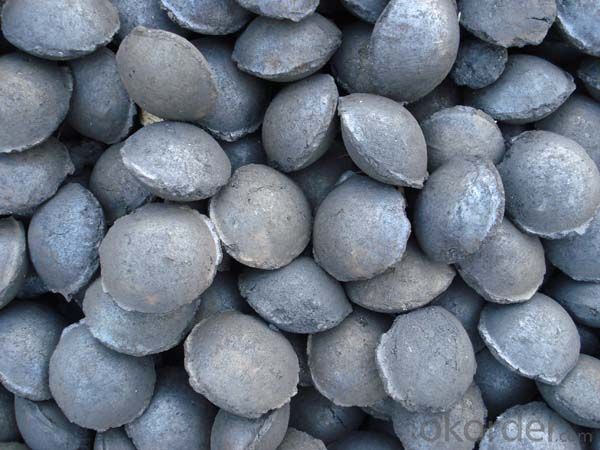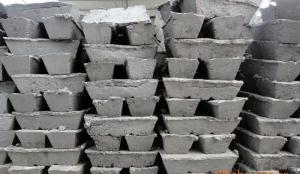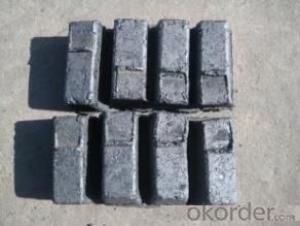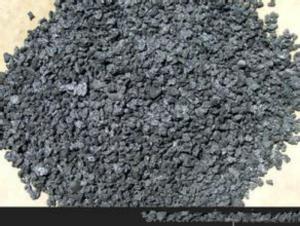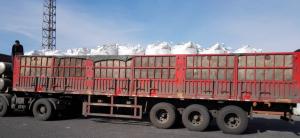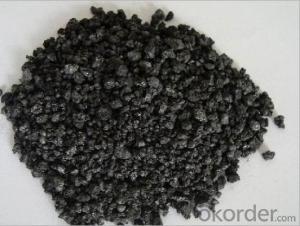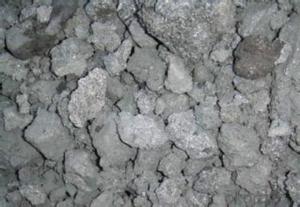Calcined Petroleum Coke with High Fixed Carbon
- Loading Port:
- Tianjin
- Payment Terms:
- TT OR LC
- Min Order Qty:
- 1 m.t.
- Supply Capability:
- 10000000 m.t./month
OKorder Service Pledge
OKorder Financial Service
You Might Also Like
1.Structure of Calcined Petroleum Coke Description
Calcined Petroleum Coke is made from raw petroleum coke,which is calcined in furnace at a high temperature(1200-1300℃).CPC/Calcined Petroleum Coke is widely used in steelmaking,castings manufacture and other metallurgical industry as a kind of recarburizer because of its high fixed carbon content,low sulfur content and high absorb rate.Besides,it is also a best kind of raw materials for producing artifical graphite(GPC/Graphitized Petroleum Coke) under the graphitizing temperature(2800℃).
2.Main Features of the Calcined Petroleum Coke
High-purity graphitized petroleum coke is made from high quality petroleum coke under a temperature of 2,500-3,500°C. As a high-purity carbon material, it has characteristics of high fixed carbon content, low sulfur, low ash, low porosity etc.It can be used as carbon raiser (Recarburizer) to produce high quality steel,cast iron and alloy.It can also be used in plastic and rubber as an additive.
3. Calcined Petroleum Coke Images

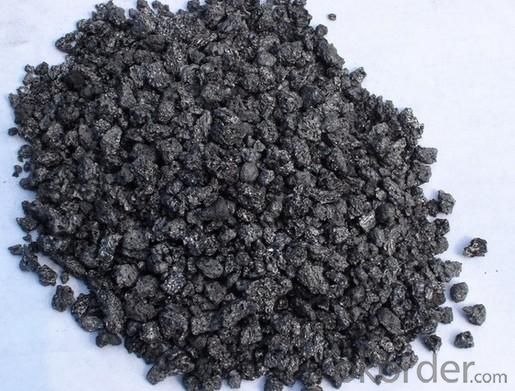
4. Calcined Petroleum Coke Specification
CALCINED PETROLEUM COKE
SPECS:
1) FC:98%MIN SULFUR:2.0%MAX MOISTURE:0.5%MAX
2) FC:98.5%MIN SULFUR:0.5%MAX MOISTURE:0.5%MAX
SIZE:1-5MM 90% MIN OR TO ORDER,
packing: IN 25kg plastic woven bag into 1 MT BAGS
5.FAQ of Calcined Petroleum Coke
1). Q: Are you a factory or trading company?
A: We are a factory.
2). Q: Where is your factory located? How can I visit there?
A: Our factory is located in ShanXi, HeNan, China. You are warmly welcomed to visit us!
3). Q: How can I get some samples?
A: Please connect me for samples
4). Q: Can the price be cheaper?
A: Of course, you will be offered a good discount for big amount.
- Q: What is the role of carbon in the corrosion of metals?
- The primary function of carbon in metal corrosion is to catalyze or facilitate the corrosion process. Carbon can react with moisture in the atmosphere to form carbonic acid, which is a weak acid, when in the form of carbon dioxide (CO2) or carbonic acid (H2CO3). This weak acid can then initiate corrosion by reacting with metal surfaces. When carbonic acid comes into contact with a metal, it can cause carbonic acid corrosion or acid attack. This reaction involves the dissolution of metal ions into a solution and the creation of metal oxide or metal hydroxide products. The presence of carbon in the form of carbon dioxide or carbonic acid can speed up corrosion by providing an electrolyte and lowering the pH of the environment, making it more corrosive. Additionally, carbon can also participate in galvanic corrosion, which happens when two different metals are in contact with an electrolyte. Graphite, in the form of carbon, can act as a conductor, allowing the flow of electrons between the two metals. This can create an electrochemical cell, leading to accelerated corrosion of the less noble metal. Apart from these direct roles, carbon can indirectly contribute to metal corrosion by forming corrosion products like carbonates or bicarbonates. These compounds can accumulate on the metal surface, resulting in the creation of a protective or non-protective corrosion layer. Depending on the specific conditions, this layer can hinder or enhance the corrosion process. In summary, carbon plays a significant role in metal corrosion by acting as a catalyst, facilitating the creation of corrosive environments, participating in galvanic corrosion, and influencing the formation of corrosion products. Understanding the role of carbon is essential in developing effective strategies for preventing and mitigating corrosion.
- Q: What are the effects of ocean acidification on marine life?
- Ocean acidification is a significant issue that poses numerous detrimental effects on marine life. The primary cause of this phenomenon is the increase in carbon dioxide (CO2) emissions, which are absorbed by the oceans, leading to a decrease in pH levels. As the ocean becomes more acidic, it has profound consequences for various marine organisms and ecosystems. One of the most vulnerable groups impacted by ocean acidification is shell-forming organisms, such as corals, mollusks, and some types of plankton. The increasing acidity reduces the availability of carbonate ions, a vital component for these organisms to build and maintain their shells or skeletons. As a result, their growth and development are hindered, making them more susceptible to predation and extinction. This not only affects these individual species but also disrupts the entire food web, as they serve as a crucial food source for many other marine organisms. Furthermore, ocean acidification has adverse effects on various marine organisms' physiology and behavior. Studies have shown that it can impair the ability of fish to detect predators, find food, and navigate, which can lead to reduced survival rates and altered migratory patterns. Additionally, acidification can disrupt reproductive processes, such as the growth and survival of fish larvae, leading to population declines and reduced biodiversity. Coral reefs, often referred to as the "rainforests of the sea," are particularly vulnerable to ocean acidification. The increased acidity inhibits the calcification process essential for coral growth, making them more susceptible to bleaching and death. As coral reefs provide crucial habitats for numerous marine species, their decline would have cascading effects on the entire ecosystem. Lastly, ocean acidification also impacts the balance of marine ecosystems by altering the composition and abundance of various species. Some organisms, such as certain types of algae, may actually benefit from increased CO2 levels and thrive, leading to an imbalance in the ecosystem. This can result in the dominance of certain species, negatively impacting the overall biodiversity and stability of the marine environment. In conclusion, ocean acidification poses significant threats to marine life. It disrupts the growth and development of shell-forming organisms, impairs the physiology and behavior of various marine species, damages coral reefs, and alters the composition of marine ecosystems. Addressing this issue is crucial to protect marine biodiversity, sustain fisheries, and maintain the overall health of our oceans.
- Q: How is carbon used in the production of carbon nanomaterials?
- Carbon is a crucial element in the production of carbon nanomaterials, as it serves as the building block for their unique structure and properties. There are various methods used to produce carbon nanomaterials, such as carbon nanotubes and graphene, all of which rely on the manipulation and organization of carbon atoms. One common method for producing carbon nanomaterials is through chemical vapor deposition (CVD). In this process, a carbon-containing gas, such as methane or ethylene, is introduced into a high-temperature furnace. Inside the furnace, the gas decomposes, releasing carbon atoms. These carbon atoms then reassemble and form nanoscale structures, such as carbon nanotubes or graphene, on a substrate or catalyst material. Another approach involves the vaporization of carbon-containing compounds, such as carbon black or graphite, using techniques like laser ablation or arc discharge. The vaporized carbon then condenses and solidifies into carbon nanomaterials with specific structures and properties. In both methods, the control of temperature, pressure, and the presence of catalysts or other additives allows for the precise manipulation of the carbon atoms, resulting in the desired carbon nanomaterials. The unique arrangement of carbon atoms in these materials, such as the hexagonal lattice structure of graphene or the cylindrical structure of carbon nanotubes, gives rise to their exceptional mechanical, electrical, and thermal properties. Overall, carbon plays a fundamental role in the production of carbon nanomaterials by providing the necessary atoms for their formation and determining their structure and properties. This knowledge and control over carbon's behavior at the atomic level enable scientists and engineers to develop nanomaterials with a wide range of applications, from electronics and energy storage to medicine and environmental remediation.
- Q: What are the advantages of carbon-based batteries?
- The advantages of carbon-based batteries include their relatively low cost, abundance of raw materials, and environmentally-friendly nature compared to other types of batteries. Additionally, they have a high energy density, allowing for longer battery life and greater power output.
- Q: How does carbon impact the prevalence of landslides?
- Carbon, in the form of carbon dioxide (CO2), plays a significant role in impacting the prevalence of landslides. One of the primary ways carbon impacts landslides is through its contribution to climate change. Increased levels of CO2 in the atmosphere result in global warming, which alters weather patterns, precipitation levels, and the overall stability of slopes and landforms. Climate change caused by carbon emissions leads to more frequent and intense rainfall events in many regions. This increased rainfall can saturate soil and increase groundwater levels, making slopes more susceptible to landslides. Additionally, intense rainfall can erode the soil, further weakening the stability of slopes and increasing the likelihood of landslides. Another way carbon impacts the prevalence of landslides is through its impact on vegetation. Carbon dioxide is a vital component of photosynthesis, the process by which plants convert sunlight into energy. However, elevated levels of CO2 can affect plant growth and productivity. Plants play a crucial role in stabilizing slopes and preventing erosion through their extensive root systems. When carbon levels are high, plants may experience reduced growth, which weakens their ability to anchor the soil and protect against landslides. Moreover, carbon emissions contribute to the melting of glaciers and permafrost, which can trigger landslides in mountainous regions. Glaciers act as natural stabilizers, holding large amounts of rock and soil in place. When glaciers melt due to global warming, the sudden release of this material can trigger landslides and result in devastating consequences. In summary, carbon impacts the prevalence of landslides primarily through its contribution to climate change and its subsequent effects on weather patterns, vegetation growth, and the stability of slopes. Addressing carbon emissions and mitigating climate change is essential in reducing the occurrence and severity of landslides.
- Q: How is carbon used in the production of batteries?
- Carbon is used in the production of batteries as it serves as a key component in the construction of electrodes. It is typically used in various forms such as graphite or carbon black, which provide a conductive surface for the flow of electrons during the charging and discharging process. The carbon-based electrodes help enhance the battery's overall performance and increase its energy storage capacity.
- Q: How is carbon stored in the Earth's crust?
- Carbon is stored in the Earth's crust in various forms and geological processes. One primary way carbon is stored is through the formation of sedimentary rocks such as limestone, dolomite, and chalk. These rocks are primarily composed of calcium carbonate, which is derived from the shells and skeletons of marine organisms that lived millions of years ago. Over time, these remains accumulate on the ocean floor and are compacted and cemented to form sedimentary rocks, effectively trapping carbon within them. Another way carbon is stored in the Earth's crust is through the process of carbonation. Carbon dioxide (CO2) from the atmosphere can dissolve in water and react with certain minerals such as basalt, forming carbonate minerals like calcite or magnesite. This process occurs naturally through chemical weathering and volcanic activity, and it helps sequester carbon within the Earth's crust. Additionally, organic carbon is stored in the form of fossil fuels such as coal, oil, and natural gas. These fossil fuels are the remains of ancient plants and microorganisms that lived and died millions of years ago. Over time, the organic matter is buried and subjected to high pressure and temperature, undergoing a process called diagenesis, which eventually converts it into fossil fuels. These deposits act as reservoirs of carbon in the Earth's crust. Overall, the Earth's crust acts as a significant carbon sink, effectively storing carbon through various processes such as the formation of sedimentary rocks, carbonation, and the accumulation of fossil fuels. However, it is important to note that human activities, particularly the burning of fossil fuels, are releasing substantial amounts of stored carbon into the atmosphere, contributing to global climate change.
- Q: How does carbon impact the stability of savannah ecosystems?
- Carbon plays a crucial role in the stability of savannah ecosystems. It is an essential element for all living organisms and is involved in various ecological processes. Carbon is primarily present in the form of organic matter, which is vital for the growth and development of plants, the primary producers in these ecosystems. In savannahs, carbon impacts stability in multiple ways. Firstly, carbon dioxide (CO2) is a key component of the Earth's atmosphere and plays a significant role in regulating the global climate. Savannas are known for their ability to sequester and store large amounts of carbon in their vegetation and soils. This carbon storage helps mitigate climate change by reducing the amount of CO2 in the atmosphere. Furthermore, carbon is essential for plant growth through photosynthesis. Savanna plants, such as grasses and scattered trees, utilize carbon dioxide from the air, converting it into carbohydrates and other organic compounds. This process not only provides plants with energy but also contributes to the overall productivity of the ecosystem. The stability of savannah ecosystems also depends on the interaction between plants and animals. Carbon-rich vegetation serves as a food source for herbivores, such as zebras and antelopes, which in turn support predators like lions and hyenas. The carbon cycle ensures a continuous flow of energy and nutrients throughout the food web, maintaining the balance and stability of the ecosystem. Moreover, the carbon content in savannah soils influences their fertility and ability to retain moisture. Organic matter, derived from decaying plant material, improves soil structure, nutrient availability, and water holding capacity. This, in turn, supports the growth of vegetation and sustains the diverse array of species found in savannah ecosystems. However, human activities, such as deforestation, agricultural practices, and the burning of fossil fuels, are altering the carbon balance in savannahs. Deforestation removes carbon-rich trees and plants, reducing the overall carbon storage capacity of the ecosystem. Additionally, the release of carbon dioxide from the burning of fossil fuels contributes to the greenhouse effect and climate change, which can disrupt the stability of savannah ecosystems. In conclusion, carbon plays a critical role in maintaining the stability of savannah ecosystems. It influences climate regulation, supports plant growth, provides energy for the food web, and enhances soil fertility. However, human activities that disrupt the carbon balance in these ecosystems can have detrimental effects on their stability and overall health. Therefore, efforts to conserve and restore savannah ecosystems are essential for preserving their carbon storage capacity and ensuring their long-term stability.
- Q: How does carbon affect the formation of wildfires?
- Carbon does not directly affect the formation of wildfires, but it plays a crucial role in their severity and intensity. Carbon-rich vegetation, such as dry grasses and dead trees, acts as fuel for wildfires, enabling them to spread rapidly and intensify. When these fuels ignite, they release carbon dioxide, a greenhouse gas that contributes to climate change. Additionally, the combustion of carbon-rich materials during wildfires releases large amounts of carbon into the atmosphere, further exacerbating global warming.
- Q: How does carbon affect the formation of toxic algal blooms?
- Toxic algal blooms can be influenced by carbon in both direct and indirect ways. Eutrophication is one direct effect, where carbon, in the form of organic matter, enters water bodies from various human activities. This excess carbon acts as a nutrient for algae, promoting their rapid growth and leading to algal blooms. Another direct effect is the impact of carbon on the composition of algal communities. Certain algae species, known as harmful algal blooms (HABs), can produce toxins that are harmful to aquatic organisms, humans, and animals. The concentration of carbon can influence the growth and dominance of HABs, creating favorable conditions for their development. Furthermore, carbon affects the chemistry of the water, including its pH levels. Changes in pH can significantly affect the physiology and behavior of algae. Some toxic algae species are more tolerant of low pH levels, which can be worsened by increased carbon dioxide levels in the water. This creates an environment that favors the growth of harmful algal blooms. Indirectly, carbon can also impact the temperature and nutrient dynamics in water bodies. Climate change, driven by increased carbon emissions, can result in warmer temperatures, which stimulate algal growth. Additionally, changes in nutrient availability due to carbon-induced alterations in the water cycle can favor the development of toxic algal blooms. In conclusion, carbon plays a significant role in the formation of toxic algal blooms through eutrophication, changes in algal community composition, alterations in water chemistry, and indirect impacts on temperature and nutrient dynamics. Understanding these relationships is crucial for developing strategies to mitigate the occurrence and impact of harmful algal blooms.
Send your message to us
Calcined Petroleum Coke with High Fixed Carbon
- Loading Port:
- Tianjin
- Payment Terms:
- TT OR LC
- Min Order Qty:
- 1 m.t.
- Supply Capability:
- 10000000 m.t./month
OKorder Service Pledge
OKorder Financial Service
Similar products
Hot products
Hot Searches
Related keywords
